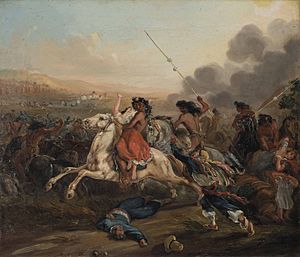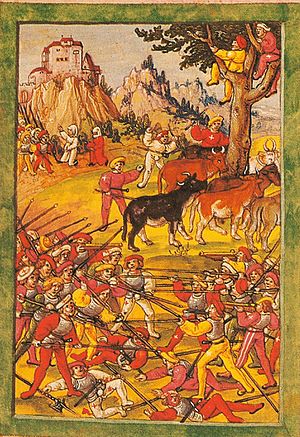Cattle raiding facts for kids
Cattle raiding is when people steal cattle. It's a very old type of theft. In Australia, this act is called duffing. The person who does it is a duffer. In North America, especially in the Wild West, stealing cattle is known as rustling. Someone who does it is called a rustler.
Contents
Cattle Raiding Through History
Stealing cattle has happened for a very long time. We know about it from over seven thousand years ago. It was a common part of early human cultures. Stories and old writings often mention it. For example, the Norse Golden Horns of Gallehus show it. The old Irish story Táin Bó Cúailnge ("Cattle Raid of Cooley") is all about it. Even the Greek god Hermes stole cattle from Apollo in ancient myths.
Cattle Raiding in Ireland and Britain
In ancient Gaelic Ireland, cattle raiding was a normal part of fighting between Irish clans. Clans might raid for food in winter or to get back at someone. Many old Irish stories, like the Táin Bó Cúailnge, show this.
Later, in the 1700s, Irish clan leaders and outlaws called rapparees kept stealing cattle. They often targeted the farms of Anglo-Irish landlords.
Around the same time, Scottish clan chiefs offered "protection" to wealthy landowners. They would guard cattle herds for money. If cattle were stolen, the chiefs would get them back or pay for them. This money helped feed their clans.
Cattle raiding was also a big problem for centuries along the border between England and Scotland. Groups called the Border reivers often stole cattle from both sides.
Cattle Rustling in the American Old West
In the American frontier, stealing cattle was a very serious crime. Sometimes, groups of citizens called vigilantes would punish thieves by hanging or shooting them.
Before the Mexican–American War (1846–1848), cattle raiding caused problems between Mexico and the United States. Native American tribes from the north often raided cattle in Mexico. Tribes like the Apache and Comanche took advantage of Mexico's weaker army. They stole many animals for themselves and to sell in Texas and the U.S. These raids killed thousands and hurt northern Mexico.
During the American Civil War (1861–1865), Mexican rustlers were a big issue. The Mexican government was even accused of helping them. American rustlers also stole cattle from Mexico. It was easier to steal calves that had not been branded yet.
A major conflict over suspected rustling happened in the Johnson County War of 1892 in Wyoming.
Over time, the practice of open range grazing changed. Fences became more common, which made rustling harder. In the 1900s, a new type of rustling appeared. Thieves would make cattle sleep and then take them directly to sell at auctions. This often happens at night. It can be hard for police to catch them because on big ranches, it takes days to notice cattle are missing.
Cattle Raiding in Chile and Argentina


Cattle raiding became a big problem in Argentina in the late 1800s. Cattle stolen during malones (raids) were taken across the Andes mountains to Chile. There, they were traded for firearms. Several native groups and outlaws, like the Boroano and Ranquel peoples, stole cattle.
To stop these raids, the Argentine government built a system of trenches called Zanja de Alsina in the 1870s. Most cattle raids ended after military campaigns in the 1870s. The border between Chile and Argentina was then set in 1881.
A Mapuche chief named Mañil wrote a letter to the Chilean President. He complained about people stealing Mapuche silver from graves. He also mentioned houses being burned and other bad acts against Mapuches. Mañil even said a local leader was getting rich from stealing cattle.
After the War of the Pacific, many Chilean soldiers returned home. The Chilean Army also stopped the Mapuche resistance in the Occupation of Araucanía (1861–1883). This led to more bandits and former soldiers moving into the Araucanía area. They often teamed up with displaced Mapuche people. Stealing cattle became their main business. They sold the stolen animals in local markets.
Modern Cattle Raiding (1990–Present)
East Africa
In northwestern Kenya, the Pokot and Samburu people often raid each other for cattle. This violent cattle rustling has caused many deaths. For example, in March 2001, a raid among the Marakwet people killed many.
Sudan
Cattle rustling is a major problem in rural areas of South Sudan. In the state of Jonglei, cattle raids in August 2011 killed about 600 people. In January 2012, more fighting related to cattle theft killed between 2,000 and 3,000 people. It also forced 34,500 people to leave their homes near Pibor.
West Africa
Cattle rustling is common in Nigeria.
Israel
Farmers in Israel face a big problem with theft. Thieves steal sheep, goats, cows, tractors, and watering equipment. About 400 cases are reported each year in northern Israel. In the south, farmers say it's like the Wild West. They lose millions of shekels every year. Most stolen animals are taken to the West Bank. They are quickly killed and then secretly brought back into Israel. There, butchers sell the meat to people who don't know it was stolen.
See also
 In Spanish: Abigeato para niños
In Spanish: Abigeato para niños



